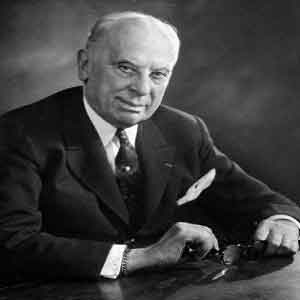Alfred Sloan
Introduction
Alfred Pritchard Sloan, Jr. (May 23, 1875 – February 17, 1966) was an American business executive in the automotive industry. He was a long-time president, chairman, and CEO of General Motors Corporation. Sloan, first as a senior executive and later as the head of the organization, helped lead (and grow) GM from the 1920s through the 1950s—decades when concepts such as the annual model change, brand architecture, industrial design, automotive design (styling), and planned obsolescence transformed the industry, and when the industry changed lifestyles and the built environment in America and throughout the world.
Sloan is remembered for being a rational, shrewd, and very successful manager, who led GM to become the largest corporation on earth, a position it held for many years after his death. His rationality and shrewdness are also remembered by his critics as extending even to cold, plutocratic detachment or avarice. However, the magnitude of Sloan's philanthropy suggests that he saw himself differently—a man with greater talents and greater responsibilities than others, who was thus entitled to authority but also obligated to, and committed to, beneficence.
Like Henry Ford—a contemporary of Sloan with a rather special relationship to him as the other "head man" of an automotive colossus—Sloan is remembered today with a complex mixture of admiration for his accomplishments, appreciation for his philanthropic legacy and unease or reproach about his attitudes during the interwar period and World War II.
Early Days
Sloan was born in New Haven, Connecticut. He studied electrical engineering and graduated from the Massachusetts Institute of Technology in 1895. While attending MIT he joined the Delta Upsilon fraternity.
He became president and owner of Hyatt Roller Bearing, a company that made roller and ball bearings, in 1899. Oldsmobile was Hyatt's first automotive customer, with many other companies soon following suit. In 1916 Hyatt merged with other companies into United Motors Company, which soon became part of General Motors Corporation. Sloan became Vice-President of GM, then President (1923), and finally Chairman of the Board (1937). In 1934, he established the philanthropic, nonprofit Alfred P. Sloan Foundation. GM under Sloan became famous for managing diverse operations with financial statistics such as return on investment; these measures were introduced to GM by Donaldson Brown, a protege of GM vice-president John J. Raskob. Raskob came to GM as an advisor to Pierre S. du Pont and the du Pont corporation; the latter was a principal investor in GM whose executives largely ran GM in the 1920s.
Business Acumen
Sloan is credited with establishing annual styling changes, from which came the concept of planned obsolescence. He also established a pricing structure in which (from lowest to highest priced) Chevrolet, Pontiac, Oldsmobile, Buick and Cadillac—referred to as the ladder of success—did not compete with each other, and buyers could be kept in the GM "family" as their buying power and preferences changed as they aged. These concepts, along with Ford's resistance to the change in the 1920s, propelled GM to industry sales leadership by the early 1930s, a position it retained for over 70 years. Under Sloan's direction, GM became the largest industrial enterprise the world had ever known.
In the 1930s GM, long hostile to unionization, confronted its workforce, newly organized and ready for labor rights, in an extended contest for control. Sloan was averse to violence of the sort associated with Henry Ford. He preferred the subtle use of spying and had built up the best undercover apparatus the business community had ever seen up to that time. When the workers organized the massive Flint Sit-Down Strike in 1936, Sloan found that espionage had little value in the face of such open tactics.
Achievements
The world's first university-based executive education program—the Sloan Fellows—was created in 1931 at MIT under the sponsorship of Sloan. A Sloan Foundation grant established the MIT School of Industrial Management in 1952 with the charge of educating the "ideal manager", and the school was renamed in Sloan's honor as the Alfred P. Sloan School of Management, one of the world's premier business schools. Additional grants established a Sloan Institute of Hospital Administration Sloan Program in Health Administration in 1955 at Cornell University Cornell University-the first two year graduate program of its type in the US, a Sloan Fellows Program at Stanford Graduate School of Business in 1957, and at London Business School in 1965. They became degree programmes in 1976, awarding the degree of Master of Science in Management. Sloan's name is also remembered in the Sloan-Kettering Institute and Cancer Center in New York. In 1951, Sloan received The Hundred Year Association of New York's Gold Medal Award "in recognition of outstanding contributions to the City of New York."
Sloan maintained an office in 30 Rockefeller Plaza in Rockefeller Center, now known as the GE Building. He retired as GM chairman on April 2, 1956. His memoir and management treatise, My Years with General Motors, was published in 1964. Sloan died in 1966. Sloan was inducted into the Junior Achievement U.S. Business Hall of Fame in 1975.
The Alfred P. Sloan Foundation is a philanthropic non-profit organization established by Sloan in 1934. The Foundation's programs and interests fall into the areas of science and technology, standard of living, economic performance, and education and careers in science and technology. The total assets of the Sloan Foundation have a market value of about $1.8 billion.



